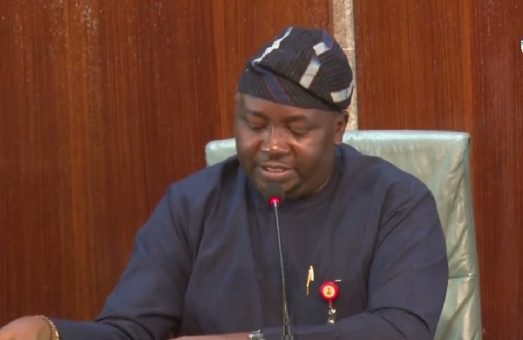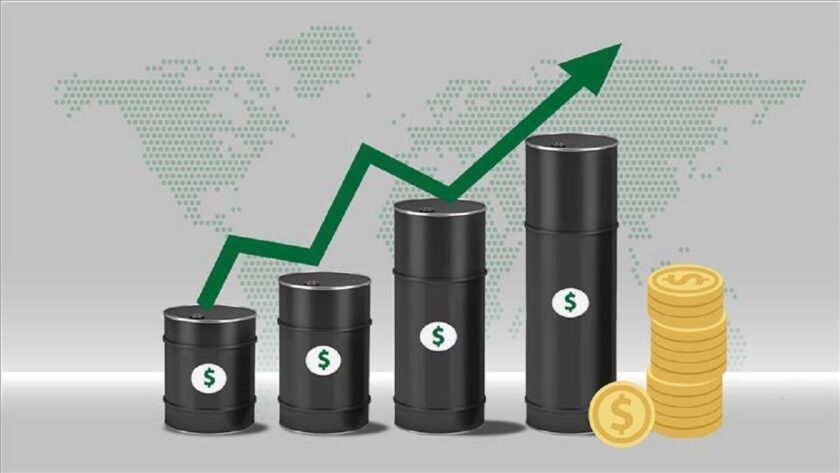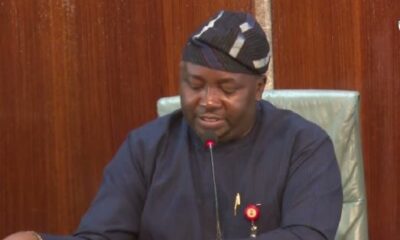Energy
NUPRC sets stage to safeguard divestments, ensure seamless oil asset transition

• Over $400m in Pre-sale D & A liabilities secured
The Chief Executive of the Nigerian Upstream Petroleum Regulatory Commission (NUPRC), Gbenga Komolafe, has said Nigeria is applying lessons from costly global divestment cases to safeguard its oil and gas sector, securing over $400 million in decommissioning liabilities and setting stricter rules for recent asset transfers.
The CCE made the disclosure yesterday while making his remarks at the Nigerian Extractive Industries Transparency Initiative (NEITI) Companies Forum, held in Lagos.
The CCE who was represented by the Deputy Director, Human Resources, Corporate Services and Administration, Efemona Bassey, spoke on the theme, “Divestments, Liabilities, and the Impact of Ongoing Reforms on Extractive Companies in Nigeria.”
In a statement made available to newsmen and signed by the Commission’s Head, Media and Strategic Communications, Eniola Akinkuotu, Komolafe said the NUPRC had drawn lessons of divestments from incidents of the North Sea, where decommissioning is estimated at £27billion by 2032, the Gulf of Mexico costing over $9b and in Canada’s Alberta, more than 97,000 inactive or abandoned wells now carry an estimated decommissioning and abandonment cost of between C$30b and C$70b. he noted that in Australia, Northern Oil & Gas Australia in 2019 left behind liabilities of more than AU$200m.
The CCE stated that the lessons from these experiences guided the recent divestment approvals from NAOC to Oando Energy Resources; Equinor to Chappal Energies; Mobil Producing Nigeria Unlimited to Seplat Energies; SPDC to Renaissance Africa Energy; and TotalEnergies to Telema Energies.
“Without a robust and enforceable framework for abandonment and decommissioning, divestment transitions can create lasting financial and environmental burdens. Nigeria is not immune to this challenge and if we are to avert costly mistakes, it is precisely to avoid this outcome that Nigeria, through the Petroleum Industry Act and subsequent regulatory actions, has taken bold and decisive steps,” Komolafe said.
The NUPRC boss highlighted Nigeria’s response to the recent divestments in line with Sections 232 and 233 of the PIA which place full responsibility for the decommissioning and abandonment of petroleum wells, installations, structures, utilities, plants, and pipelines on licensees and lessees.
Similarly, Chapter 3 of the PIA and Section 104 of the PIA, establish specific obligations for host community development and environmental remediation respectively.
He said each of the 2024 divestments provided a critical opportunity to put the Commission’s Divestment Framework to test and action: rigorously assessing the technical capacity of acquiring entities, verifying their financial strength, and securing decommissioning and abandonment obligations through upfront escrow arrangements.
Hear him: “The results from 2024 speak for themselves. Over US$400 million in pre-sale decommissioning and abandonment liabilities have been secured through Letters of Credit and escrow accounts.
“Host Community Development Trust obligations are fully honoured. Environmental remediation commitments worth over US$9.2 million have been pledged while awaiting the formal gazetting of the ERF Regulations.”
The CCE said beyond the significant progress achieved through our Divestment Framework, it is important to highlight another milestone.
“Since April 2023, we have approved 94 Decommissioning and Abandonment (D&A) plans, in strict alignment with the PIA. These approvals represent total liabilities of $4.424 billion, arising from all Field Development Plans submitted within this period, and will be remitted progressively over the production life of the respective fields into designated escrow accounts,” he added.
He further disclosed that the Commission has addressed a long-standing concern with the IOCs regarding the domiciliation of the escrow accounts; and the regulatory framework, developed after extensive consultations with industry stakeholders, is now awaiting gazetting by the Ministry of Justice.
He acknowledged the invaluable role of NUPRC partners, NEITI and Oil Producers Trade Section (OPTS).
According to him, as the moral compass of the extractive industry, NEITI has consistently ensured that NUPRC embedded transparency and disclosure in all its regulatory processes while OPTS, the united voice of producers, has supported us in shaping regulations that balance industry realities with national priorities.
He added, “In addition to divestments, the Commission has been working together with operators, particularly members of OPTS, on life extension projects, ranging from facility integrity audits to subsea upgrades and enhanced reservoir management measures that sustain safe production, delay decommissioning, reduce environmental risks, and secure resilience across our mature fields.”
Energy
8,500 transmission capacity: Low demand stalls generation of 3,500MW

• Nigeria conducts grid synchronisation test connecting 15 countries for four hours
The Ministry of Power yesterday said despite the availability of 8,500MW transmission capacity in the Nigerian Electricity Supply Industry (NESI), low demand from the Distribution Companies (DisCos) has limited generation to 5,000MW, stalling 3,500MW.
As of July 17, 2025, the wheeling capacity was 5,500MW.
But the ministry disclosed its recent wheeling capacity in Abuja during a media briefing where it announced that Nigeria successfully conducted a grid synchronization test with 15 West African countries for four hours on November 8, 2025.
“Today, the minimum grid capacity we can even communicate is 8,500MW of capacity. If our generation reaches 8,000 MW today, the grid can comfortably and conveniently transmit it,” Adelabu said.
Besides, the Nigerian Independent System Operator (NISO), Market Operation Executive Director, Dr. Edmund Eje, explained that since electricity cannot be stored, the industry only generates energy based on demand.
His words: “The amount of energy generated is equal to the amount of energy that will be transmitted, and it is also equal to the amount of energy that is demanded by the distribution companies. It is simultaneously consumed.
“You don’t stall energy anywhere. The transmission capacity can carry 8,500MW, but it can only carry what can be consumed. Generators will not generate more than what will be consumed at the same time.”
On synchronization, he said the feat of successful synchronization will not affect the allocation of energy for domestic consumption.
Eje said that although there is a regulation that Nigeria allocates 600MW for bilateral trade, production constraints presently limit it to 360MW.
Adelabu, however, described the synchronization test success as a step towards the elimination of grid collapse from the industry, noting it means that there is confidence that the system is now resilient.
He described it as a landmark development in the evolution of West Africa’s electricity architecture.
He confirmed that on 8th November 2025, Nigeria successfully conducted a grid synchronisation test connecting the national electricity grid with the interconnected West African Power Pool (WAPP) system.
According to him, the exercise represents the first time in history that Nigeria has operated in a unified, stable, and fully harmonised configuration with the rest of the sub-region.
He clarified that while it is not yet a permanent synchronisation, the successful test clearly demonstrates that regional technical alignment is feasible and marks a major step toward eventual full integration.
Adelabu further noted that the synchronisation exercise, conducted between 05:04 a.m. and 09:04 a.m., involved the Nigerian grid which includes Niger Republic and parts of Benin and Togo and the rest of West Africa’s interconnected systems covering Ghana, Côte d’Ivoire, Burkina Faso, Liberia, Sierra Leone, Guinea, Senegal, The Gambia, Guinea Bissau, and Mali.
He said for four uninterrupted hours, power flowed seamlessly across national borders, operating at a single stable frequency and proving that West Africa is now technically capable of functioning as a unified power bloc.
He said the achievement ranks among the most significant milestones in the history of WAPP.
He said the test marks the first successful large-scale synchronisation attempt since 2007, when a short-lived trial lasted only seven minutes before failing.
Adelabu said Nigeria has made history with the successful synchronization of the national grid with the West African Power Pool interconnected system.
For four unbroken hours, according to him, electricity flowed from Nigeria and Niger into the entire West African sub-region covering Benin, Togo, Ghana, Côte d’Ivoire, Liberia, Sierra Leone, Guinea, Senegal, Mali, The Gambia, and Guinea-Bissau operating at a single, stabilized frequency.
Earlier at the NISO Maiden Stakeholders’ Engagement, the Managing Director, Engr. Abdul Mohammed said the milestone recorded with the synchronization milestone is more than a technical success, since it positions Nigeria as a regional power hub; opens new avenues for electricity trading; unlocks foreign exchange potential; and reinforces investor confidence in the emerging Nigerian electricity market.
According to him, a resilient electricity market requires more than engineering; it requires relationships.
He said it requires trust among service providers, trust between the market and regulators, trust between the government and operators, and, above all, trust from the Nigerian people.
Energy
Brent rises 1.32% to $65 as drone strike halts 260,000bpd Russian refinery

By Grace Edet
Crude oil prices edged higher on Tuesday after a Ukrainian drone strike knocked out one of Russia’s largest refineries, disrupting 260,000 barrels per day (bpd) of processing capacity and raising fresh concerns over global supply stability as winter demand builds.
Brent crude was up 1.32 per cent at $65.05 per barrel at 9:00 WAT, with analysts warning that the outage could trigger further price increases in the coming days.
The Ryazan refinery, Russia’s fourth-largest and operated by Rosneft, has now been hit twice in less than a month as Ukraine escalates its long-range strike campaign. The latest attack halted the plant’s main crude distillation unit, which accounts for roughly 5 per y of Russia’s total refining capacity.
Industry sources told reporters that the refinery will remain shut until at least December 1, adding that “no product deliveries are expected before then,” while several secondary units have also been idled.
Prices Mixed Across the Energy Market
While Brent gained, WTI held steady at $60.90 per barrel, showing no change. Murban crude ticked up by 1.06 per cent to $66.46, whereas natural gas slipped 0.16 per cent to $4.368. Analysts say the muted price response masks rising anxiety beneath the surface.
“Market sentiment has turned cautious. If these outages persist or Moscow’s infrastructure comes under renewed fire, the supply picture could tighten very quickly,” an energy expert, Mustapha Shuaid said.
Winter Demand Meets Heightened Geopolitical Risk
The attack comes at a sensitive period, with temperatures dropping across Europe and Asia. Energy markets typically enter a high-demand phase from late November, making geopolitical disruptions more consequential.
Ukraine’s strategy has increasingly shifted toward high-impact targets. According to the Centre for European Policy Analysis, Kyiv is now focusing on “high-value refinery equipment like cracking units — assets that are harder to replace and more disruptive when damaged.”
Recent strikes have also hit terminals and export routes, including the strategic Novorossiysk port on the Black Sea.
Market Braces for Upside Risk
Although front-month prices remain relatively stable, traders say the underlying risk of a significant price upturn is rising. The outage at Ryazan, combined with the threat of additional strikes, could squeeze Russian product exports and rattle global supply chains.
“The next few weeks will be pivotal. Any escalation could be enough to disrupt balances and trigger a price rally, with spillover inflation risks for energy-dependent economies,” another analyst, Akin Owolabi told TheTrustNews.com.
With the Ryazan plant offline and Russia’s refining network increasingly exposed, the oil market enters the winter season on a fragile footing.
Energy
Diesel falls to ₦979/L in Lagos

By Grace Edet
Diesel prices in Lagos have dropped below ₦1,000 per litre for the first time in months, offering rare relief to transport operators, manufacturers and SMEs.
Market checks on Tuesday showed rates as low as ₦979 per litre at Mobil Idowu Egba, ₦980 at NNPC Retail Igando and ₦995 at Petrocam Isheri, driven by stronger domestic supply and heightened competition among retailers.
But fresh cost indicators suggest the drop may be short-lived. New data from the Major Energy Marketers Association of Nigeria (MEMAN) shows diesel landing cost has climbed to ₦980.28 per litre, signalling pressure on retailers and raising the likelihood of a price rebound.
According to market analysts, the rising landing cost is being driven by firmer international prices, higher cargo premiums and renewed bulk purchases by major distributors seeking to replenish stock.
They warn that the current sub-₦1,000 pump prices do not reflect the cost realities facing importers.
Foreign exchange volatility is compounding the pressure. The naira traded between ₦1,430 and ₦1,450 to the dollar over the past week, creating uncertainty for fuel traders and affecting forward pricing.
New coastal pricing formulas tied to Platts benchmarks are also shaping expectations for higher replacement costs.
Analysts note that Dangote Refinery’s lack of any announced price reduction is another sign that the current relief may not last. Market behaviour suggests wholesalers may soon begin building inventories in anticipation of upward adjustments.
“Diesel may have dipped below ₦1,000, but all cost indicators point to a likely rebound. Rising landing costs and FX pressure will inevitably filter through the supply chain,” a Godfrey Olatunde, a Lagos-based energy analyst told TheTrustNews.com.
With cost drivers now trending upward, stakeholders warn that the modest price drop recorded this week may be temporary as the market prepares for another adjustment.
-

 Art & Life8 years ago
Art & Life8 years agoThese ’90s fashion trends are making a comeback in 2017
-

 Entertainment8 years ago
Entertainment8 years agoThe final 6 ‘Game of Thrones’ episodes might feel like a full season
-

 Art & Life8 years ago
Art & Life8 years agoAccording to Dior Couture, this taboo fashion accessory is back
-

 Entertainment8 years ago
Entertainment8 years agoThe old and New Edition cast comes together to perform
-

 Sports8 years ago
Sports8 years agoPhillies’ Aaron Altherr makes mind-boggling barehanded play
-

 Entertainment8 years ago
Entertainment8 years agoMod turns ‘Counter-Strike’ into a ‘Tekken’ clone with fighting chickens
-

 Entertainment8 years ago
Entertainment8 years agoDisney’s live-action Aladdin finally finds its stars
-

 Business8 years ago
Business8 years agoThe 9 worst mistakes you can ever make at work














